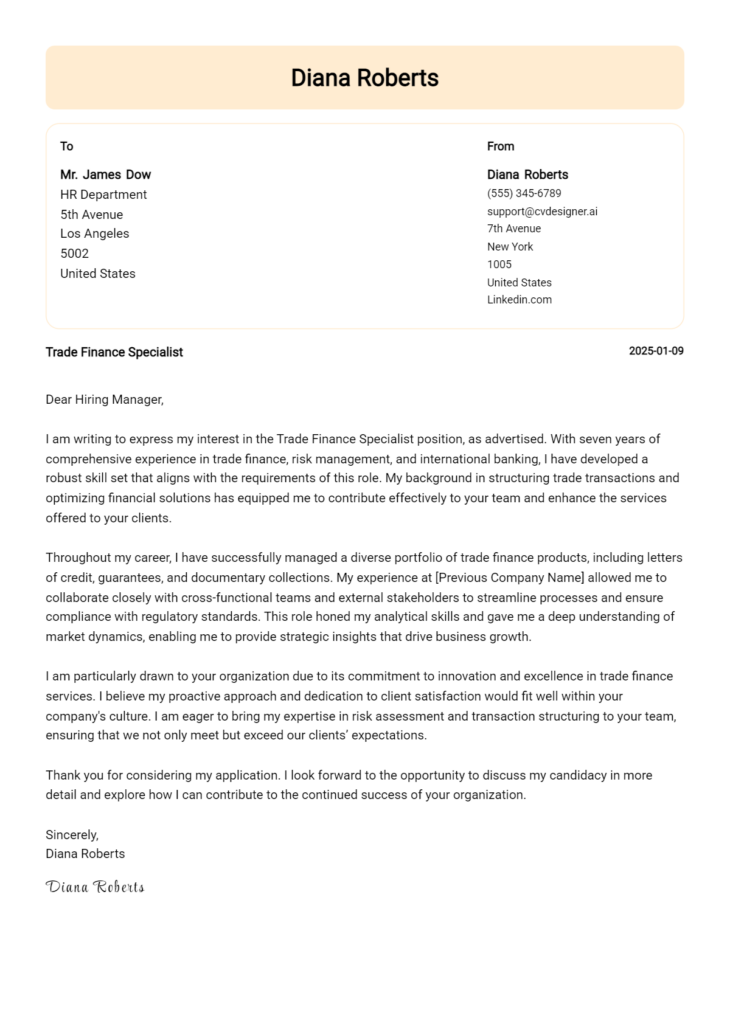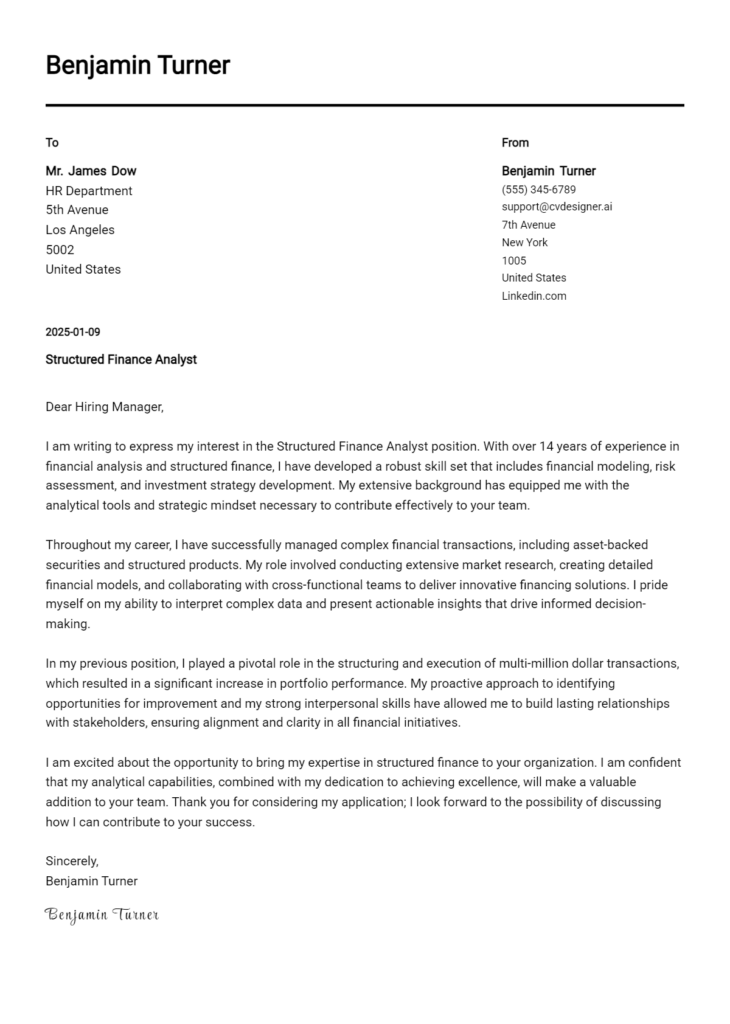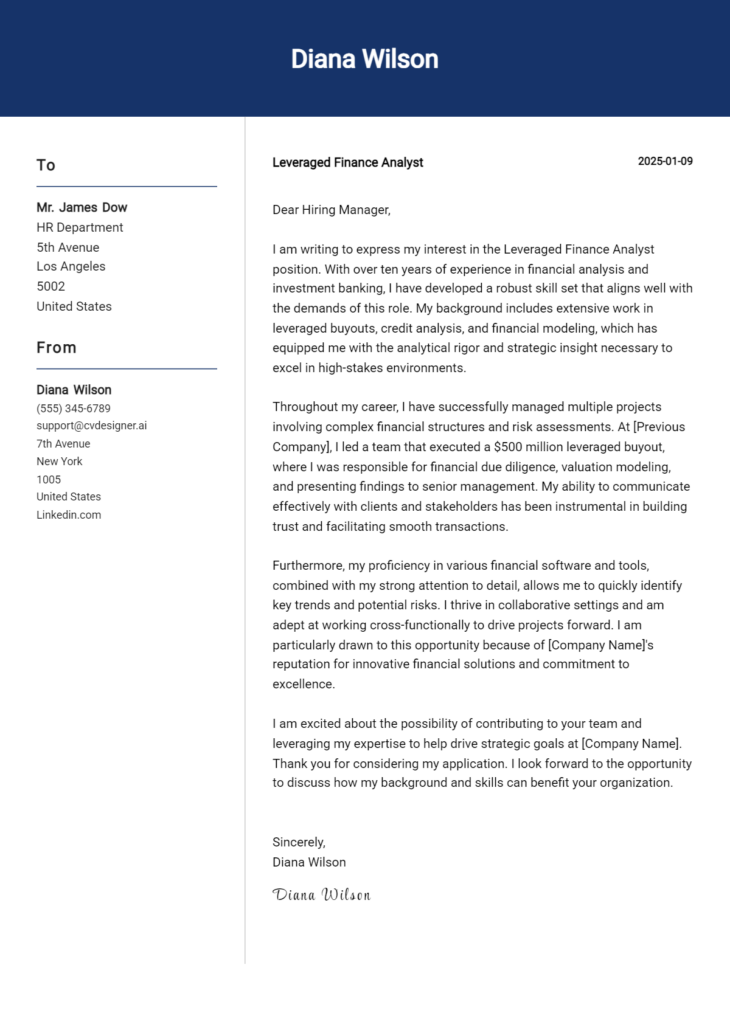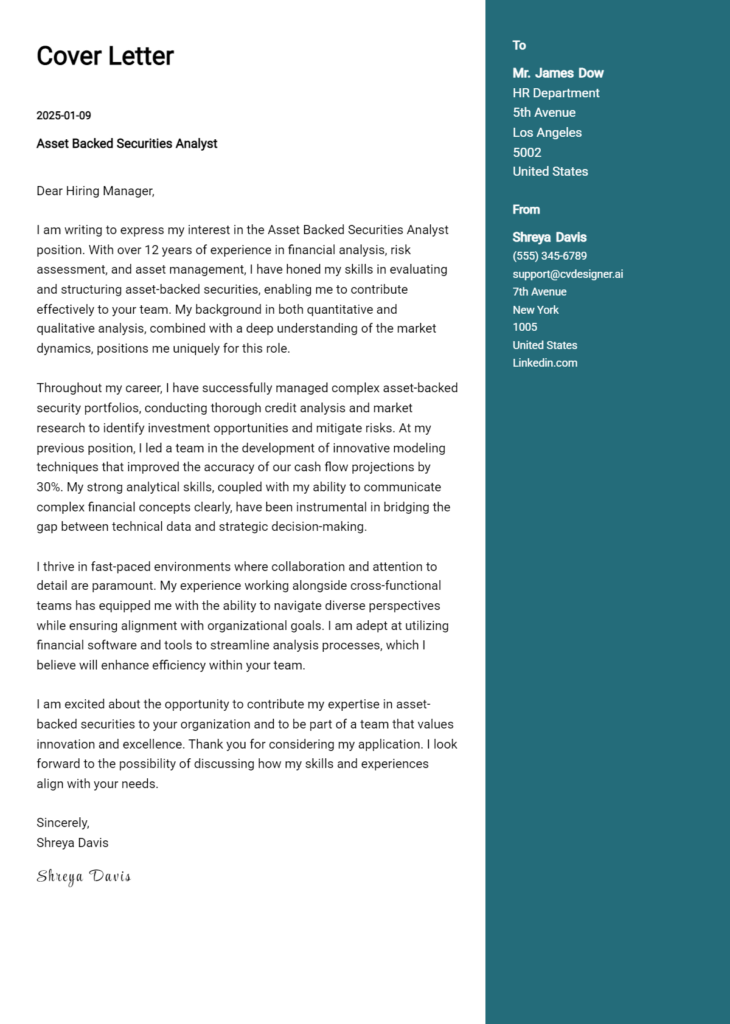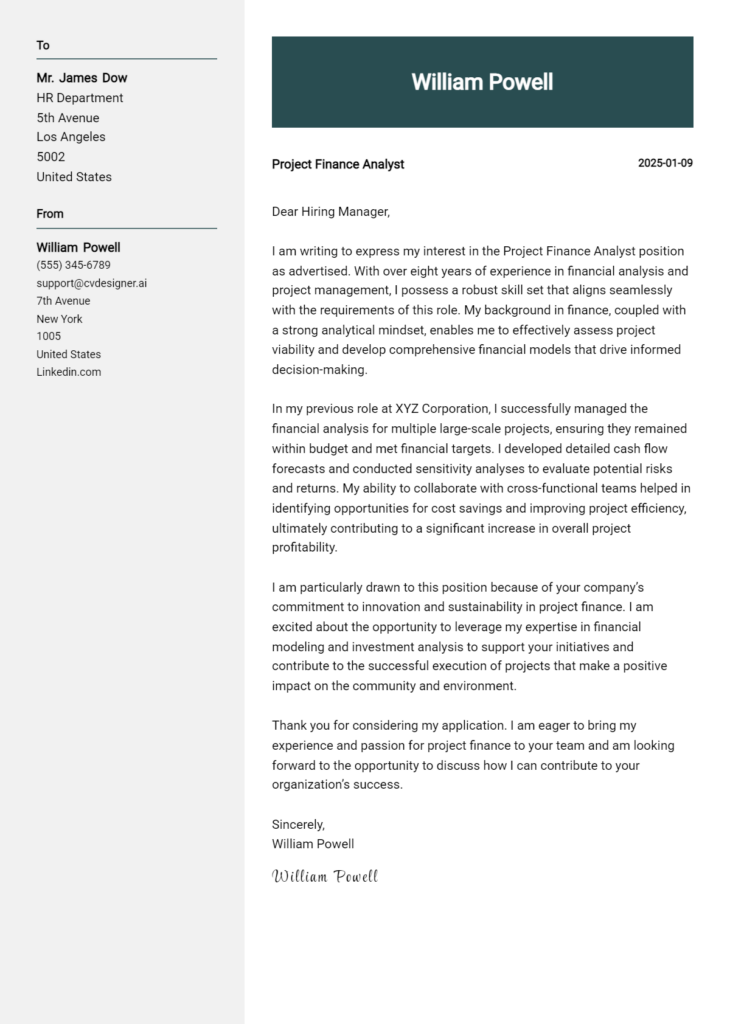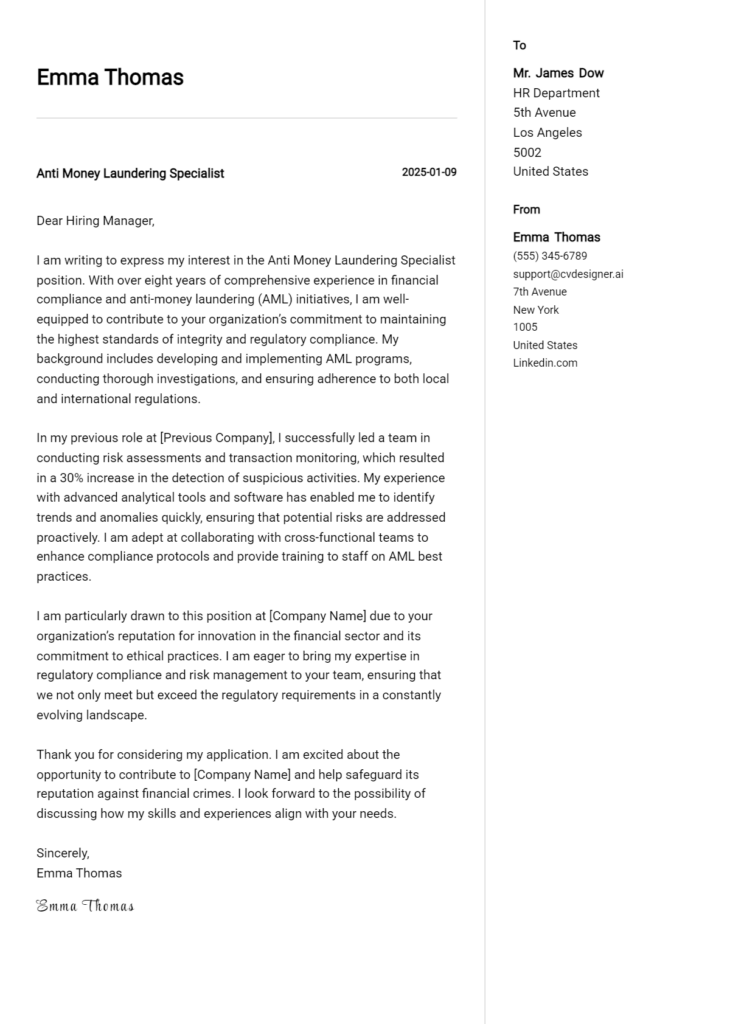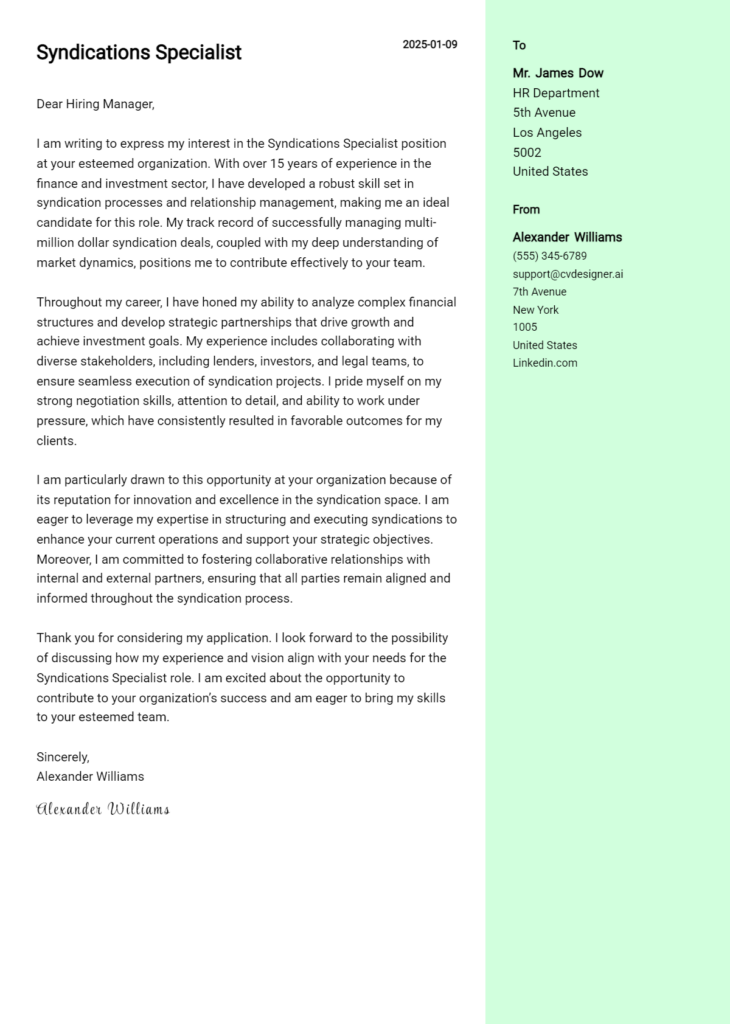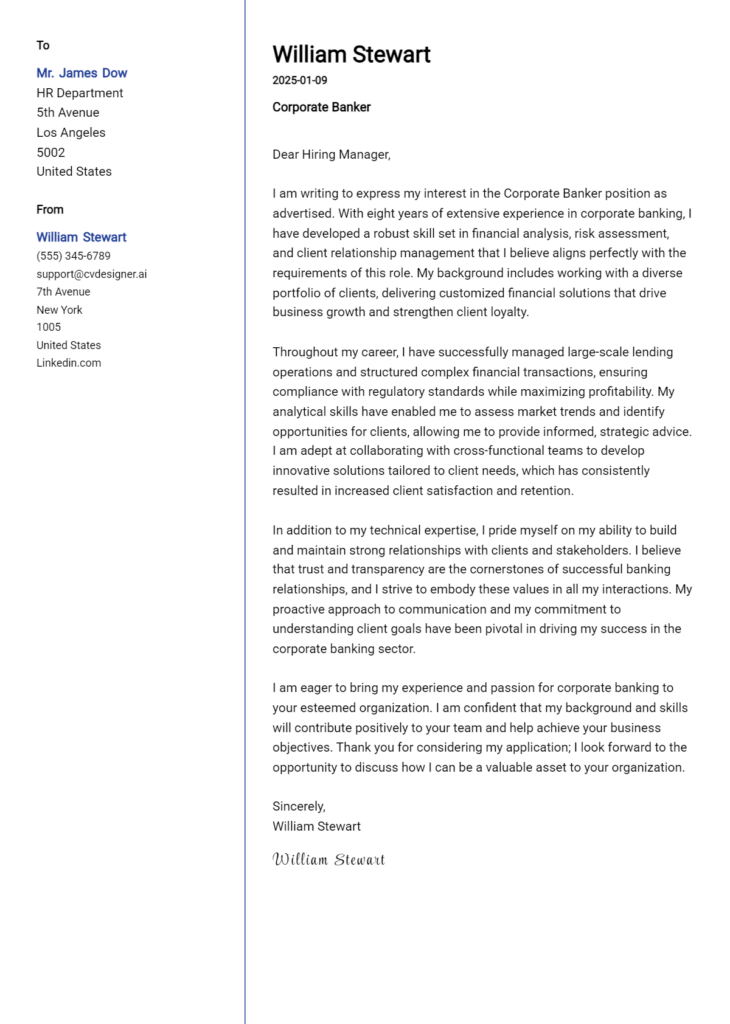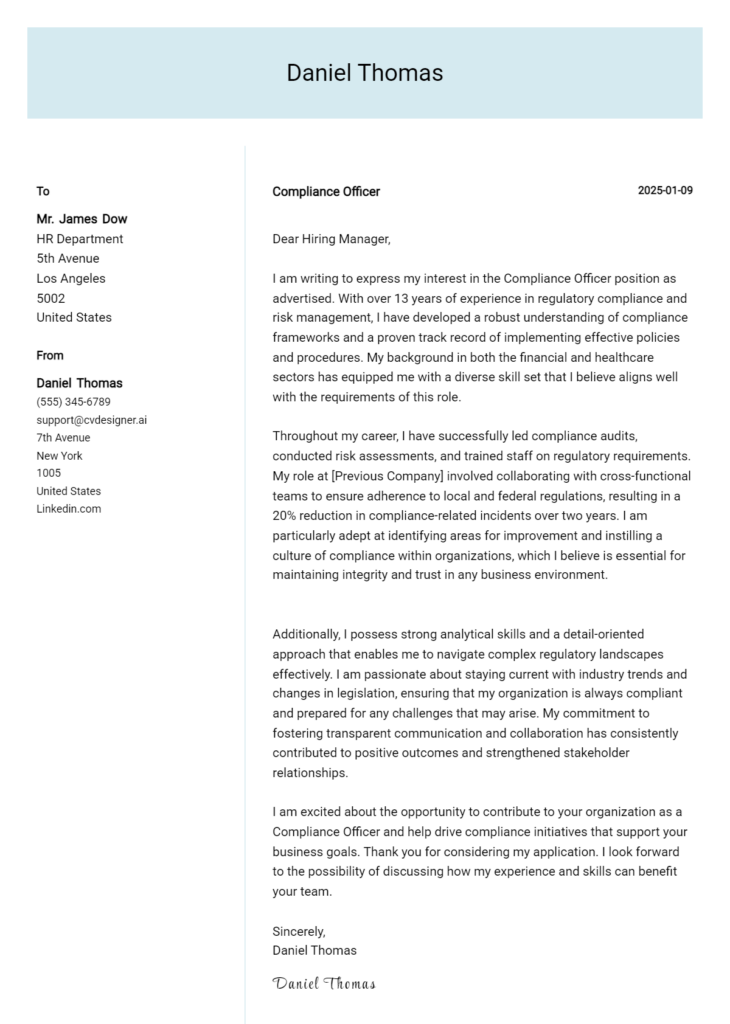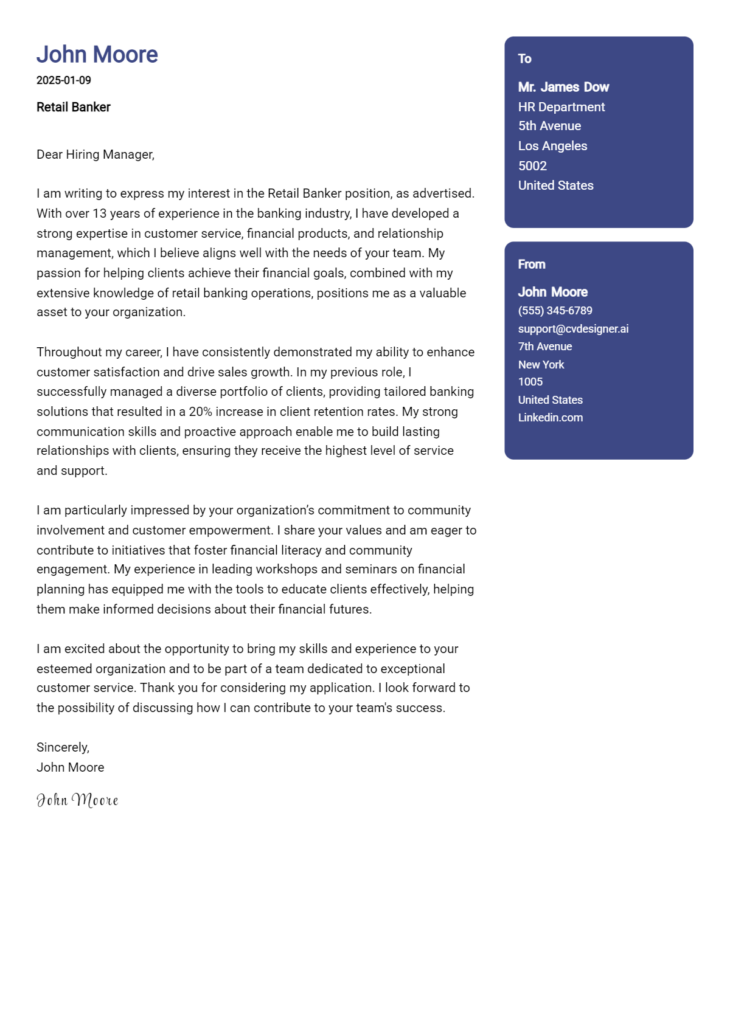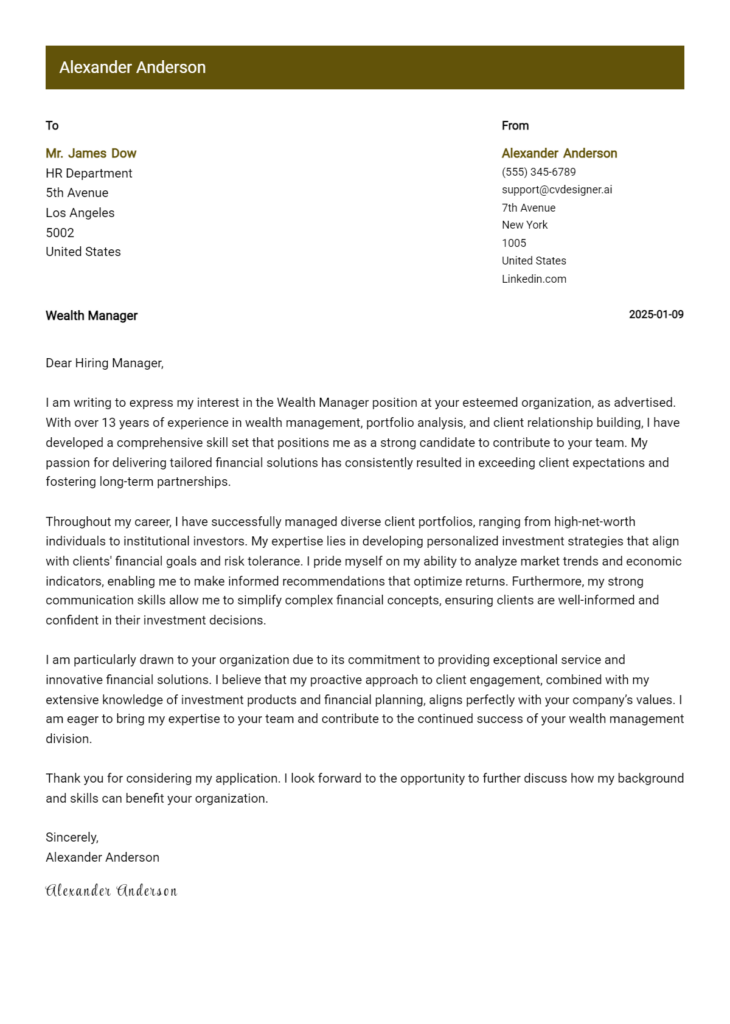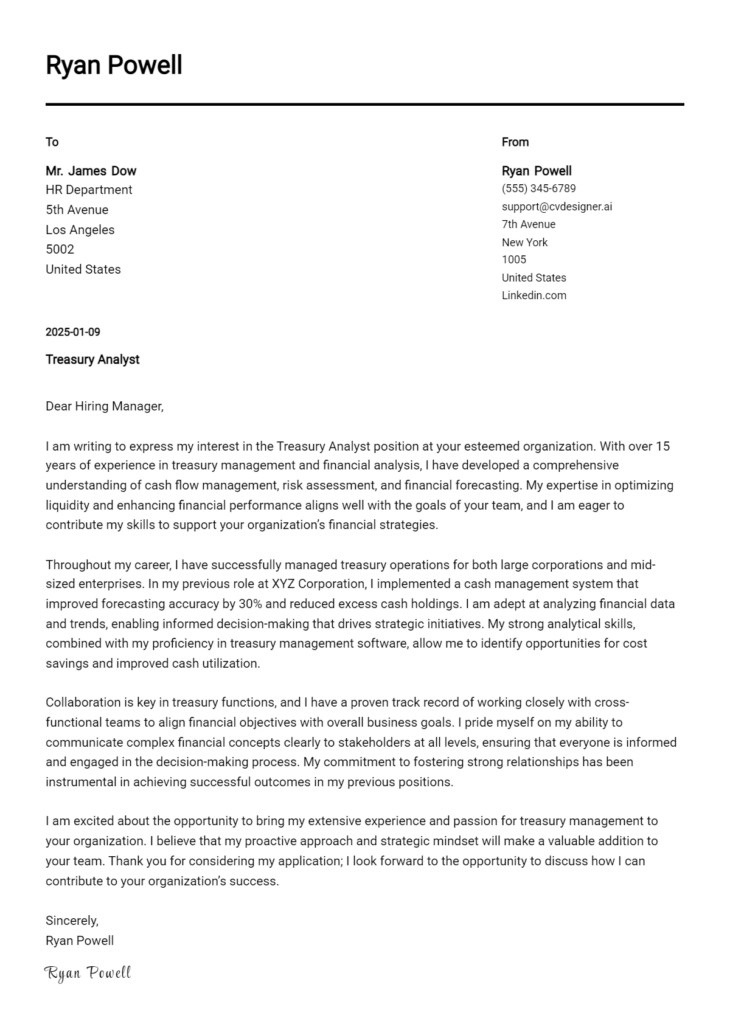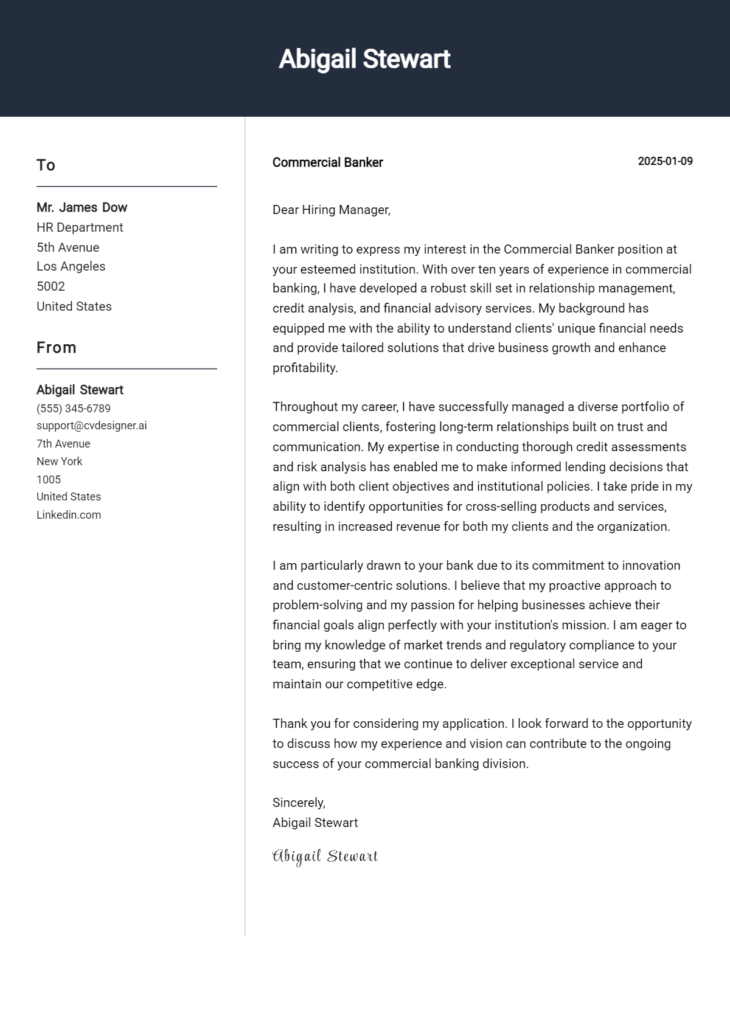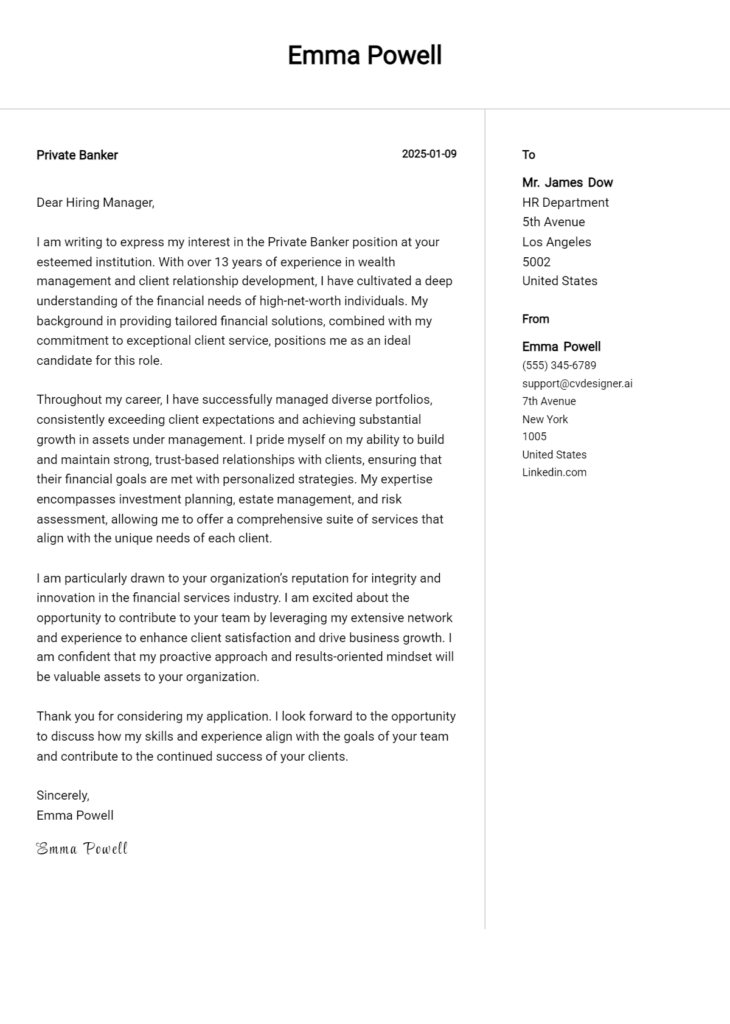Credit Analyst 2 Cover Letter Examples
Explore additional Credit Analyst 2 cover letter samples and guides and see what works for your level of experience or role.
How to Format a Credit Analyst Cover Letter?
Crafting a well-structured cover letter is essential for a Credit Analyst role, as it not only showcases your qualifications but also demonstrates your analytical skills and attention to detail. A well-formatted cover letter can immediately catch the hiring manager's eye, setting a professional tone that reflects your ability to assess financial data critically. In this guide, we will explore how to structure your cover letter effectively, ensuring that you present your skills and experience in a compelling manner.
We’ll focus on the key components of a professional cover letter, which include:
- Cover Letter Header
- Cover Letter Greeting
- Cover Letter Introduction
- Cover Letter Body
- Cover Letter Closing
Each section is crucial in illustrating your qualifications and professionalism. Let’s break down each part and discover how to make your Credit Analyst cover letter truly stand out.
Importance of the Cover Letter Header for a Credit Analyst
The cover letter header is a crucial element of any professional correspondence, particularly for a Credit Analyst position. It sets the tone for your application and provides essential information at a glance. A clear and professional header should include your contact information, the date, and the recipient’s details. This ensures that the hiring manager can easily locate your information and respond appropriately. A well-structured header not only reflects your attention to detail but also demonstrates your understanding of formal business communication, which is vital in the finance industry.
Strong Example
John Doe 1234 Finance St. Cityville, ST 12345 (123) 456-7890 john.doe@email.com October 10, 2023 Jane Smith Hiring Manager XYZ Financial Services 5678 Investment Blvd. Cityville, ST 12345
Weak Example
John 1234 St. 10/10/23 To Whom It May Concern
The Importance of the Cover Letter Greeting
The greeting of your cover letter serves as the first impression to the hiring manager, setting the tone for the rest of your application. A well-crafted greeting not only demonstrates professionalism but also adds a personal touch by addressing the hiring manager directly. This approach shows that you've taken the time to research the company and its staff, making your application stand out in a competitive job market. To create an impactful greeting, avoid generic salutations such as "To Whom It May Concern." Instead, make an effort to find the name of the hiring manager or the person in charge of the recruitment process. If you’re unable to find a specific name, consider using a more personalized title that reflects the department you're applying to.
Here are examples of strong and weak greetings for a Credit Analyst cover letter:
Strong Greeting Example
Dear Ms. Johnson,
Weak Greeting Example
To Whom It May Concern,
The Importance of a Well-Crafted Cover Letter Introduction for a Credit Analyst
A well-crafted cover letter introduction is crucial for a Credit Analyst role, as it serves as the first impression to the hiring manager. This opening paragraph should not only grab attention but also express genuine interest in the position while highlighting relevant skills or accomplishments. A strong introduction can set the tone for the rest of the letter, encouraging the reader to delve deeper into the candidate's qualifications. In contrast, a weak introduction may leave the hiring manager unimpressed or unsure about the candidate’s suitability for the role. Below are examples of strong and weak cover letter introductions for a Credit Analyst position.
Strong Example
Dear [Hiring Manager's Name], I am excited to apply for the Credit Analyst position at [Company Name], as I have a profound passion for financial analysis and risk assessment. With over five years of experience in credit risk management and a proven track record of reducing default rates by 15% through data-driven insights, I am eager to bring my analytical skills and strategic approach to your esteemed team.
Weak Example
To Whom It May Concern, I am writing to express my interest in the Credit Analyst role. I have worked in finance for a while and think I could be a good fit for the job. I have some experience, but I’m not sure how it aligns with what you’re looking for.
Purpose of the Cover Letter Body for a Credit Analyst
The cover letter body for a Credit Analyst is a critical component that allows candidates to articulate their relevant skills, experiences, and the value they bring to the organization. This section provides an opportunity to highlight specific projects or accomplishments that demonstrate analytical abilities, risk assessment skills, and financial expertise. By effectively showcasing how past experiences align with the requirements of the role, candidates can differentiate themselves from other applicants and illustrate their potential contributions to the company's success.
Strong Example
I am excited to apply for the Credit Analyst position at XYZ Financial Services, as my extensive background in credit risk assessment aligns perfectly with your team's objectives. In my previous role at ABC Bank, I successfully led a project that streamlined the credit evaluation process, reducing turnaround time by 30%. Additionally, my analysis of client portfolios resulted in a 15% decrease in default rates over a two-year period, significantly contributing to the bank's profitability. I am eager to bring my expertise in financial modeling and risk mitigation strategies to XYZ Financial Services to support your growth initiatives.
Weak Example
I am interested in the Credit Analyst position at XYZ Financial Services. I have worked in finance for a few years. I think I would be a good fit for your team. I have done some data analysis but I don’t have any specific projects to mention. I believe I can help the company because I am a quick learner.
Importance of the Cover Letter Closing for a Credit Analyst
The closing paragraph of a cover letter is crucial for a Credit Analyst as it serves to succinctly summarize qualifications, reiterate enthusiasm for the role, and encourage the hiring manager to take the next steps, such as reviewing the resume or scheduling an interview. A strong closing leaves a lasting impression and reinforces the applicant’s fit for the position, while a weak closing can diminish the overall impact of the letter.
Strong Example
Thank you for considering my application for the Credit Analyst position. With my extensive experience in financial analysis, risk assessment, and a proven track record of improving lending decisions, I am confident in my ability to contribute effectively to your team. I am very enthusiastic about the opportunity to work at [Company Name] and believe that my skills align well with your needs. I look forward to the possibility of discussing my application further. Please feel free to contact me to schedule an interview at your convenience.
Weak Example
Thanks for reading my letter. I hope you like my resume. If you want to talk, that would be cool. Let me know what you think.
These tips will assist candidates in crafting an effective cover letter for a Credit Analyst position. A well-written cover letter can set you apart from other candidates by showcasing your technical skills, problem-solving abilities, understanding of the Software Development Life Cycle (SDLC), teamwork experience, and a commitment to continuous learning. By emphasizing these qualities, you can demonstrate your suitability for the role and your potential to contribute positively to the organization.
Cover Letter Writing Tips for Credit Analyst
Highlight Technical Skills: Clearly articulate your technical competencies relevant to the role, such as proficiency in financial modeling, risk assessment tools, or data analysis software. Use specific examples to illustrate how you've applied these skills in previous roles or projects, reinforcing your capability to handle the analytical demands of a Credit Analyst.
Showcase Problem-Solving Abilities: Credit Analysts often face complex financial scenarios that require innovative solutions. Include a brief example of a challenging situation you encountered and how you approached it. Detail the steps you took to analyze the problem, the solution you implemented, and the positive outcome that resulted from your actions.
Demonstrate SDLC Knowledge: If your experience includes involvement in projects that utilize the Software Development Life Cycle, make sure to mention it. Illustrate your understanding of how SDLC principles apply to financial systems or data management, and describe any specific roles you played in relevant projects, emphasizing your ability to contribute to system improvements or new implementations.
Emphasize Teamwork Experience: Collaboration is essential in finance roles. Share insights into how you've successfully worked within a team setting, whether in cross-functional projects or during departmental initiatives. Highlight your communication skills and your ability to work collaboratively to achieve common goals, showcasing how you can contribute to a positive team dynamic.
Express a Passion for Continuous Learning: The finance industry is ever-evolving, and demonstrating a commitment to staying updated with trends, regulations, and tools is vital. Mention any relevant certifications, courses, or seminars you’ve attended, and express your eagerness to continue developing your skills. This not only shows your dedication but also highlights your proactive approach to professional growth.
Common Mistakes to Avoid in a Credit Analyst Cover Letter
Avoiding common mistakes in a cover letter is crucial for standing out as a strong candidate for a Credit Analyst position. A well-crafted cover letter can set you apart from other applicants and demonstrate your attention to detail and professionalism. Here are some common pitfalls to watch out for:
Generic Content: Failing to customize your cover letter for the specific job can make it seem impersonal. Always tailor your letter to reflect the company’s values and the job description.
Lack of Specific Examples: Not providing concrete examples of your skills or experiences can weaken your case. Use specific instances from your past work to illustrate your qualifications.
Overly Technical Language: While industry jargon can showcase your expertise, too much technical language can alienate the reader. Strive for a balance that maintains professionalism while remaining accessible.
Ignoring Formatting: A cluttered or unprofessional format can detract from your message. Use clear headings, bullet points, and a consistent font to enhance readability.
Typos and Grammatical Errors: Simple mistakes can undermine your credibility. Always proofread your letter several times and consider having a friend review it for errors.
Neglecting a Strong Introduction: A weak opening can fail to grab attention. Start with a compelling statement or a brief overview of your qualifications to engage the reader right away.
Failure to Show Enthusiasm: A lack of passion for the role can be off-putting. Express genuine interest in the position and the company to convey your enthusiasm.
By being mindful of these common mistakes, you can create a more impactful cover letter that captures the attention of hiring managers and increases your chances of landing an interview.
Cover Letter FAQs for Credit Analyst
What should I include in my cover letter for a Credit Analyst position?
When writing a cover letter for a Credit Analyst role, focus on including specific skills and experiences relevant to the position. Highlight your analytical abilities, attention to detail, and familiarity with financial modeling and credit risk assessment. Mention any relevant educational background, such as a degree in finance, accounting, or economics. It's also beneficial to discuss your proficiency with financial software and tools, as well as your understanding of credit markets. Additionally, provide examples of past achievements, such as improving credit assessment processes or reducing bad debt rates. Tailoring your cover letter to the job description will demonstrate your genuine interest and suitability for the role.
How can I demonstrate my analytical skills in my cover letter?
To effectively showcase your analytical skills in your cover letter, use concrete examples from your past experiences. Describe specific projects where you utilized data analysis to assess creditworthiness or evaluate risk. For instance, you might mention a time when you analyzed financial statements to identify trends that informed lending decisions. Highlight any quantitative metrics you achieved, such as improving loan approval rates or reducing default rates through your analyses. Additionally, emphasize your ability to interpret complex financial data and present it clearly to stakeholders. This not only demonstrates your analytical prowess but also your communication skills, both essential for a Credit Analyst.
Should I include any certifications in my cover letter?
Yes, including relevant certifications in your cover letter can significantly enhance your application. Certifications such as Chartered Financial Analyst (CFA), Financial Risk Manager (FRM), or Certified Credit Professional (CCP) indicate a high level of expertise and commitment to your profession. When mentioning these certifications, briefly explain how they have equipped you with the necessary skills and knowledge for the Credit Analyst role. For example, you might state how your CFA training has deepened your understanding of financial markets and investment analysis. Including certifications not only sets you apart from other candidates but also reflects your dedication to continuous professional development.
How should I format my cover letter for a Credit Analyst job?
The format of your cover letter should be professional and easy to read. Start with your contact information at the top, followed by the date and the employer's contact information. Use a standard business letter format, with a clear and concise introduction that states the position you are applying for and how you learned about it. In the body, structure your paragraphs logically, focusing on your qualifications and how they relate to the job. Aim for a length of one page, using a professional font like Arial or Times New Roman, size 10-12. Finally, close with a strong conclusion that expresses your enthusiasm for the role and a call to action, such as a request for an interview.
Build your Cover Letter in minutes
Use an AI-powered cover letter builder and have your letter done in 5 minutes. Just select your template and our software will guide you through the process.



